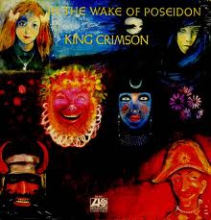MENNO VON BRUCKEN FOCK
IN THE WAKE OF POSEIDON (1970, E), heruitgave

King Crimson already played the music from their debut album In The Court Of The Crimson King (1969) and from their second album In The Wake Of Poseidon (1970) whilst performing live in the late sixties and in 1970. A mere change in the line-up, made a huge difference because obviously my favourites would be the tracks penned by Ian McDonald and he only contributed to less than two tracks and he is no longer credited as a member of this illustrious outfit. Most of the tracks were composed by Robert Fripp, and the lyrics by Pete Sinfield. The complete line-up of this second album is Robert Fripp (guitar, Mellotron, devices), Mel Collins (saxophone, flute), Greg Lake (lead vocals), Michael Giles (drums), Peter Giles (bass), Keith Tippet (piano), Gordon Haskell (vocals) and Peter Sinfield (lyrics). The first track Peace - A Beginning is almost exclusively a soft vocal solo sung by Lake, followed by the more powerful and quite jazzy track Pictures Of A City, a mixture of rock, blues and jazz featuring the saxophone played by Collins. The melodies and the way Greg Lake sings make this track quite comparable with 21st Century Schizoid Man. It fades away near the end but the band returns to a sort of cacophonic finale. In contrast with these last notes is Cadence And Cascade, a subtle ballad featuring the acoustic guitar, piano and flute. Giles' drumming is held back while a few minutes before his playing was very busy with one fill after another. Peter Giles plays the bass in a way that matches the melancholic sound of the song. The majestic sounds of the mighty Mellotron open the title track. In my opinion this is one of the few highlights on this album and definitely in the vein of melodic songs like Epitaph or In The Court Of The Crimson King from the debut. While the music is slow and symphonic, the drumming of Giles is rather filling and mixed in the fore. Peace - A Theme is a guitar solo by Fripp, classically orientated and if you wouldn't know who was playing, you could mistakenly have thought that you were listening to Steve Hackett. The song Cat Food is a bit weird because of the somewhat bluesy theme played by Giles in the vein of Come Together by The Beatles. It has a good melody line, but the deliberate atonal harsh piano sounds distracts the listener from the simple but catchy melody while Lake sings in a rock style. The resemblance with some of the early works by Emerson, Lake & Palmer (ELP) is striking. The Devil's Triangle consists of three parts. Part one, Merday Morn, is a rather slow, soft and symphonic introduction, followed by a bombastic piece played on the Mellotron from which I think Tony Banks (Genesis) got inspired when he wrote the intro to Watcher Of The Skies. Part two, Hand Of Sceiron, has now begun and the music is getting fiercer leading to a cacophonic climax as in A Day In A Life by The Beatles. The last part, Garden Of Worm, continues after a pause where the music in part two stopped, with a heavy Mellotron-sound, drums and bass, followed by a piece played with more instruments, sounding like a spontaneous jam and to my disappointment flowing into sheer cacophony. Funny thing is the chorus of In The Court Of The Crimson King can be heard just for an instant. Greg Lake sings solo again with a part similar to the opening tune.
With this successor King Crimson was a disappointment to me, because this album is far less melodic than the debut and the next step of Fripp and Sinfield would be to fill the gap of having no vocalist by recruiting Gordon Haskell. Greg Lake went on to form ELP. When a fellow named John Wetton joined the band, things began to become of more interest to me. Both musically and technically only parts of this album can measure up to the debut and later albums like Larks' Tongues In Aspic (1973), Starless And Bible Black (1974) and Red (1974).